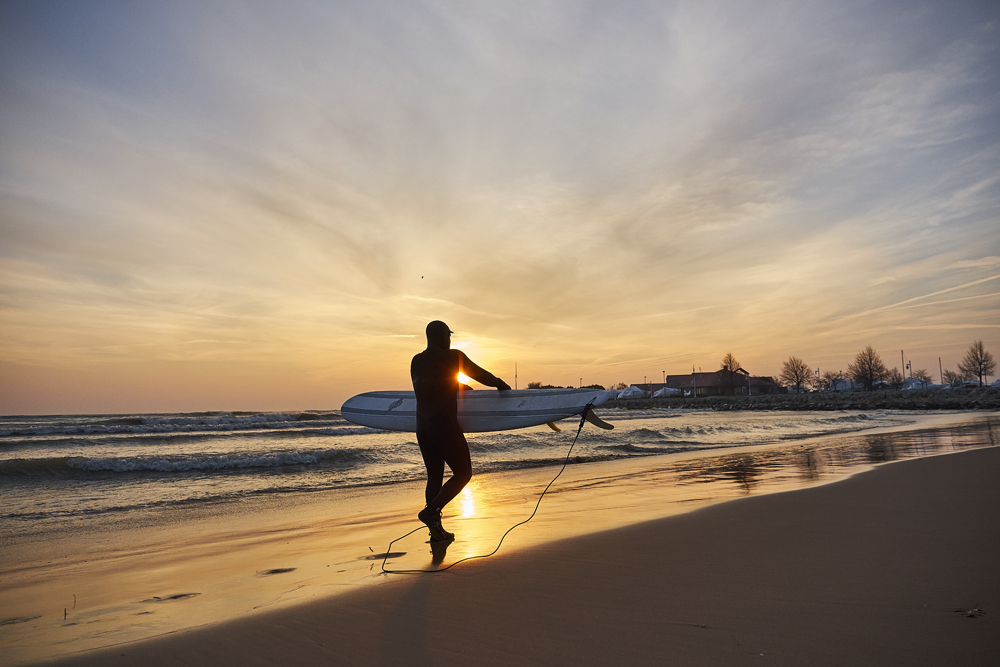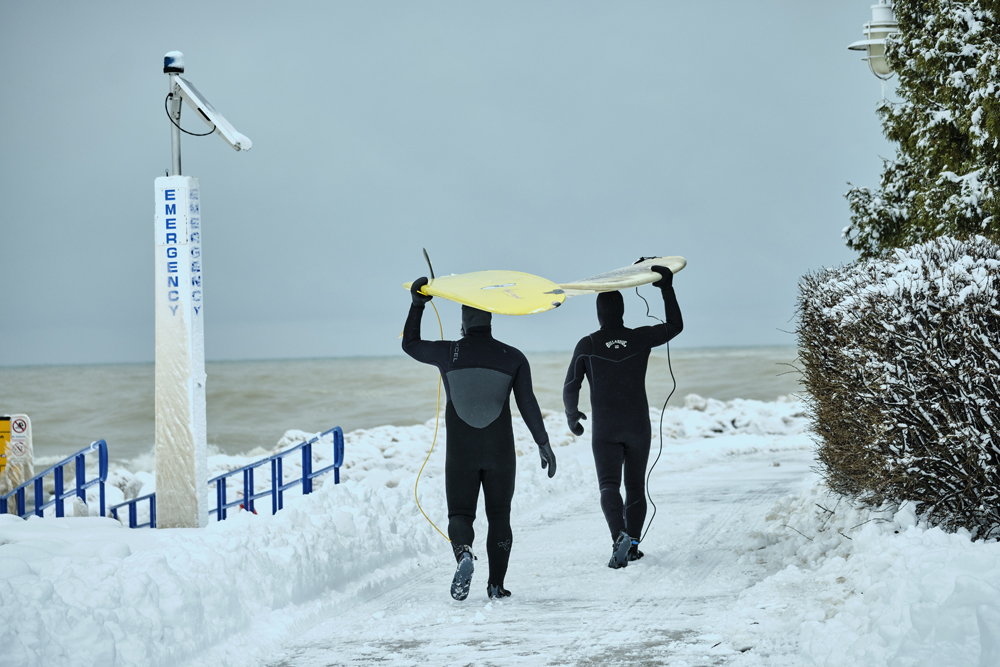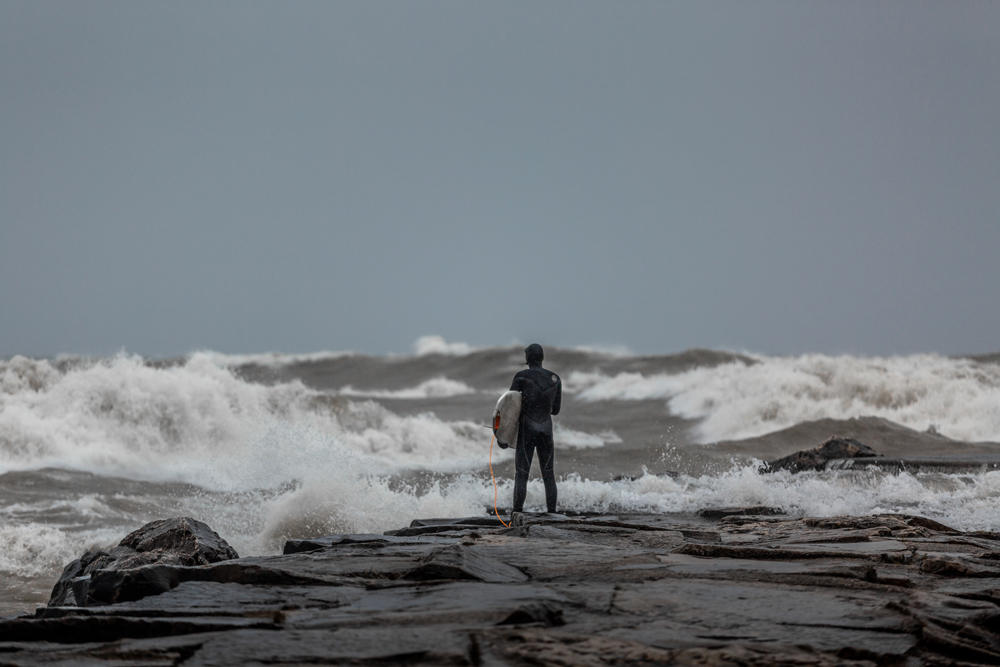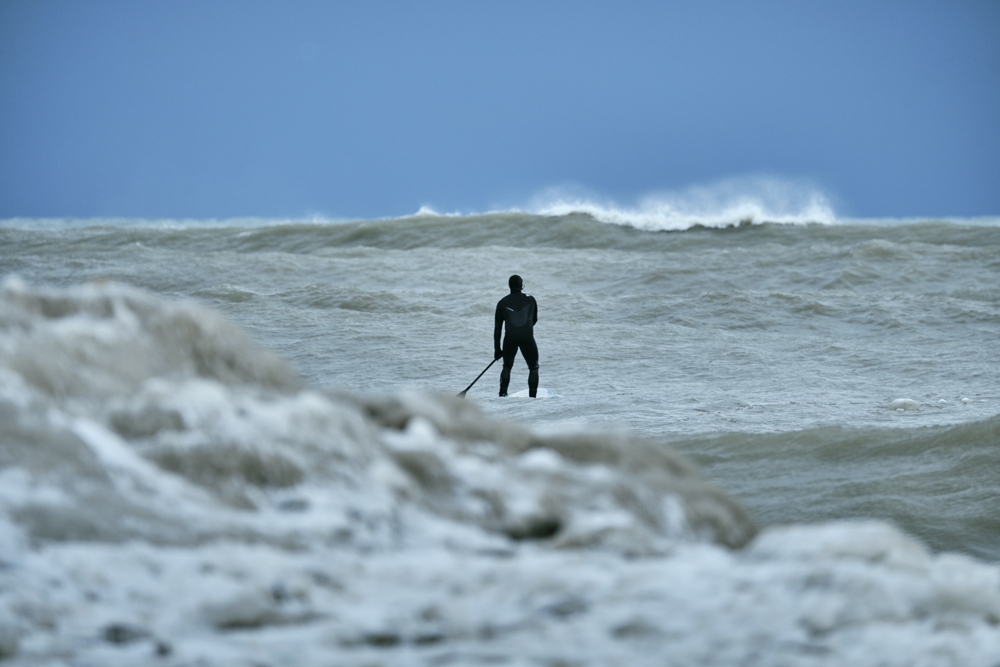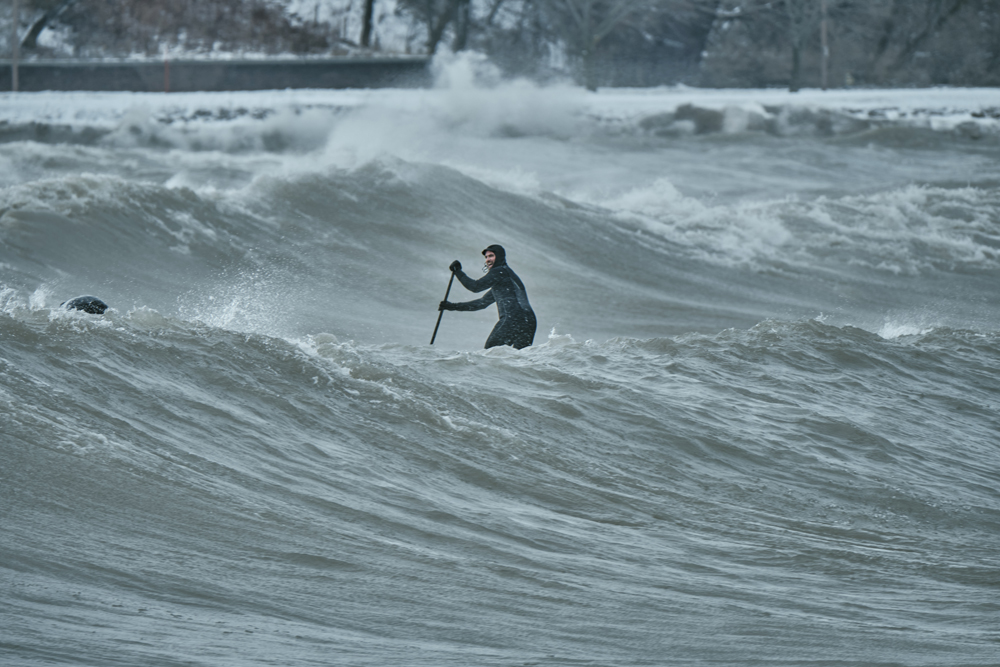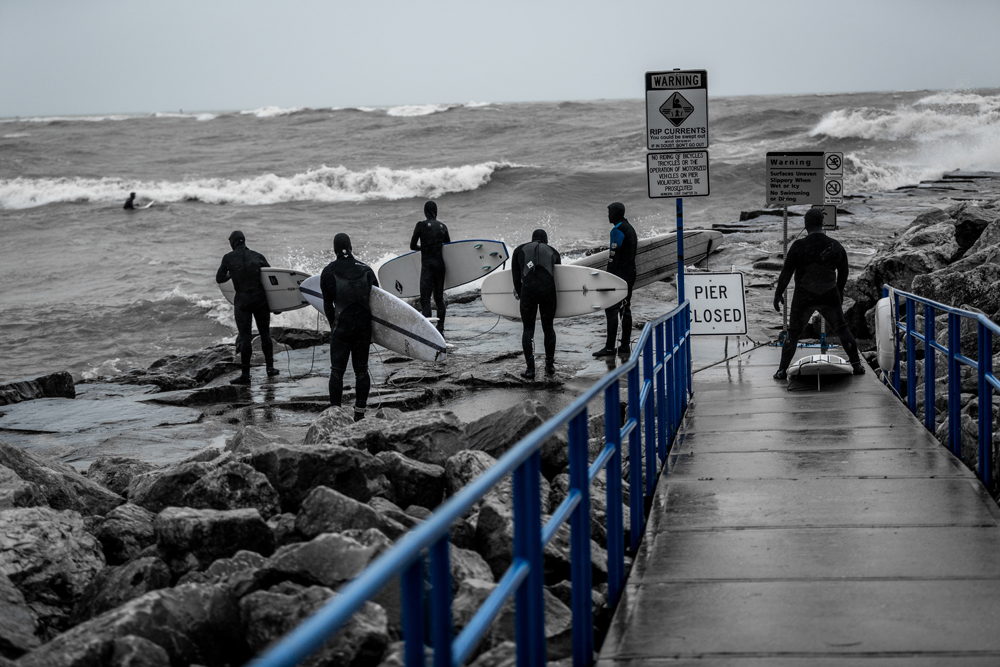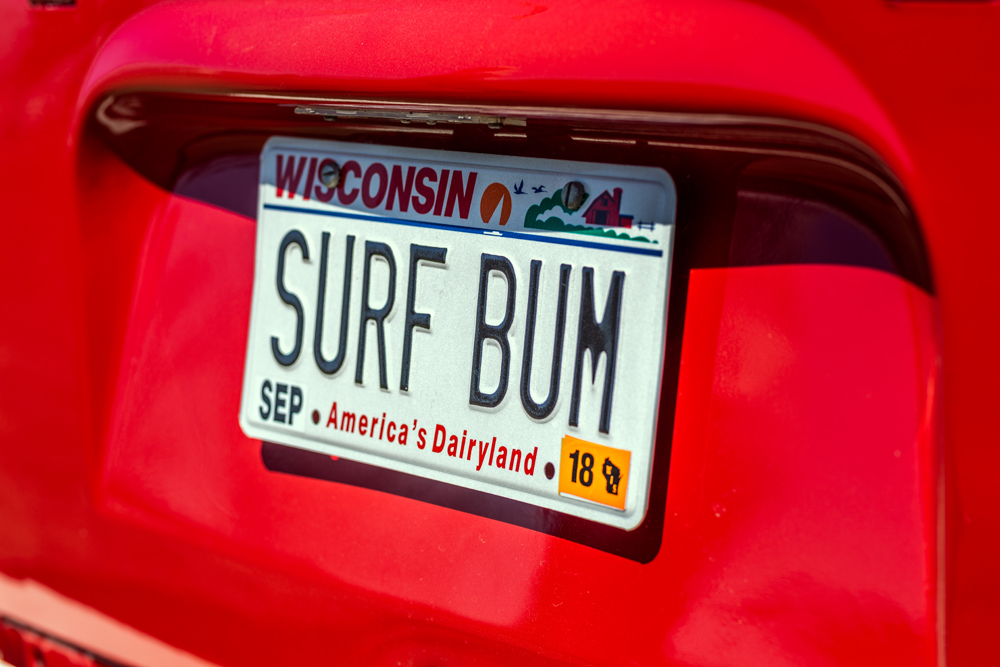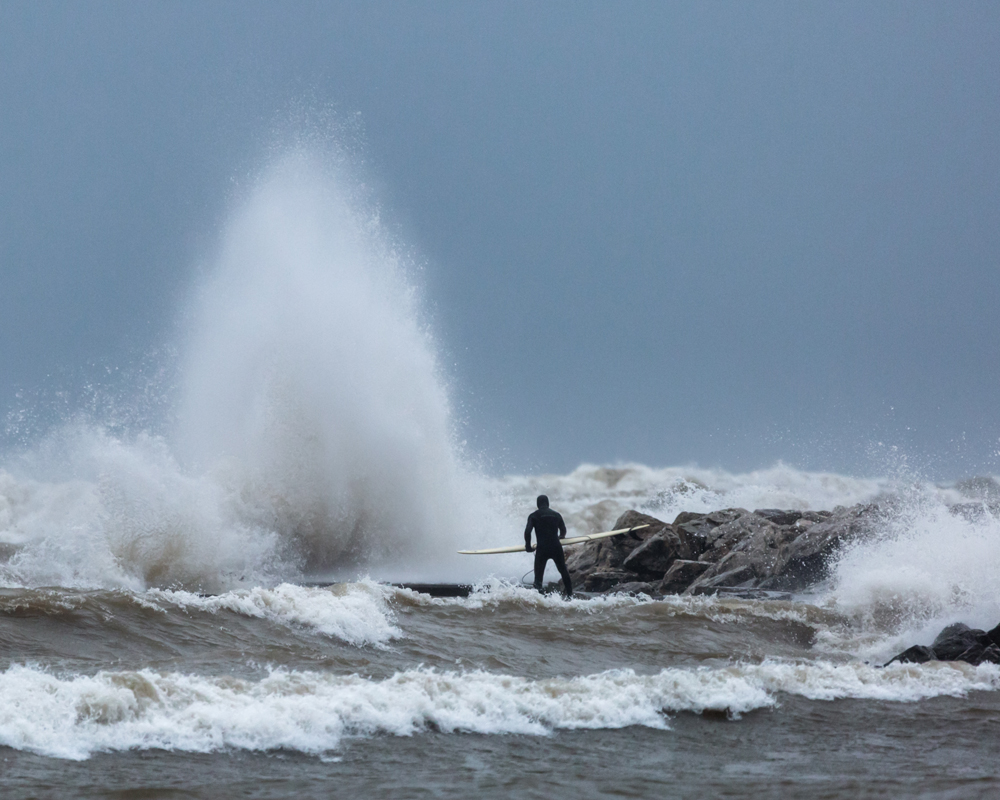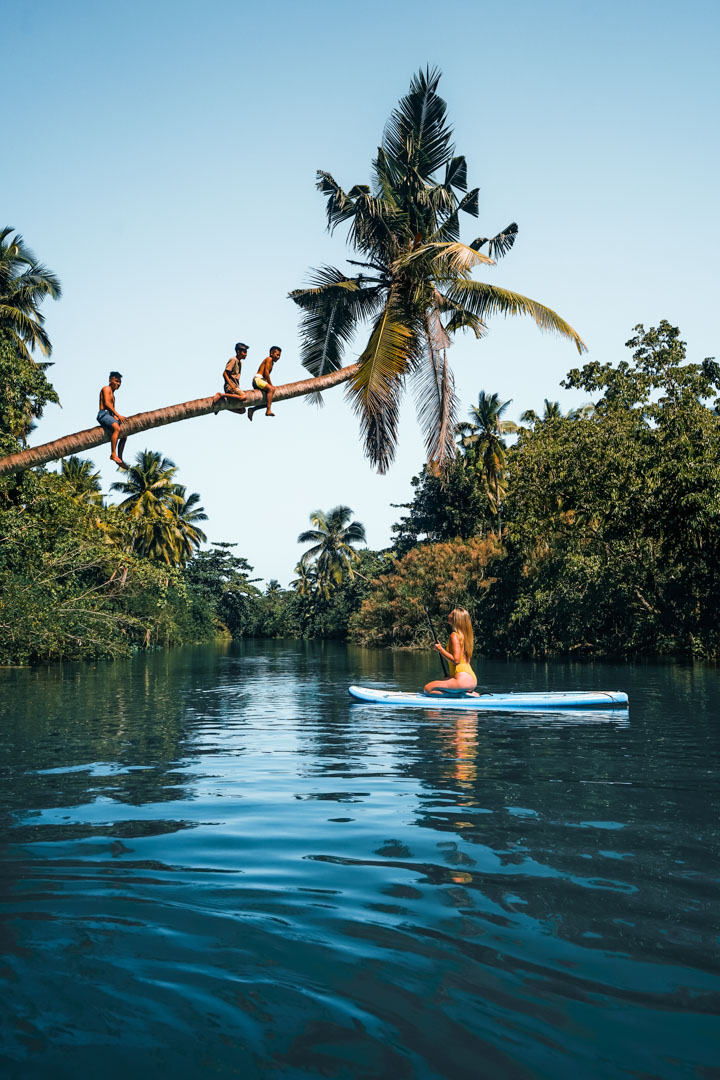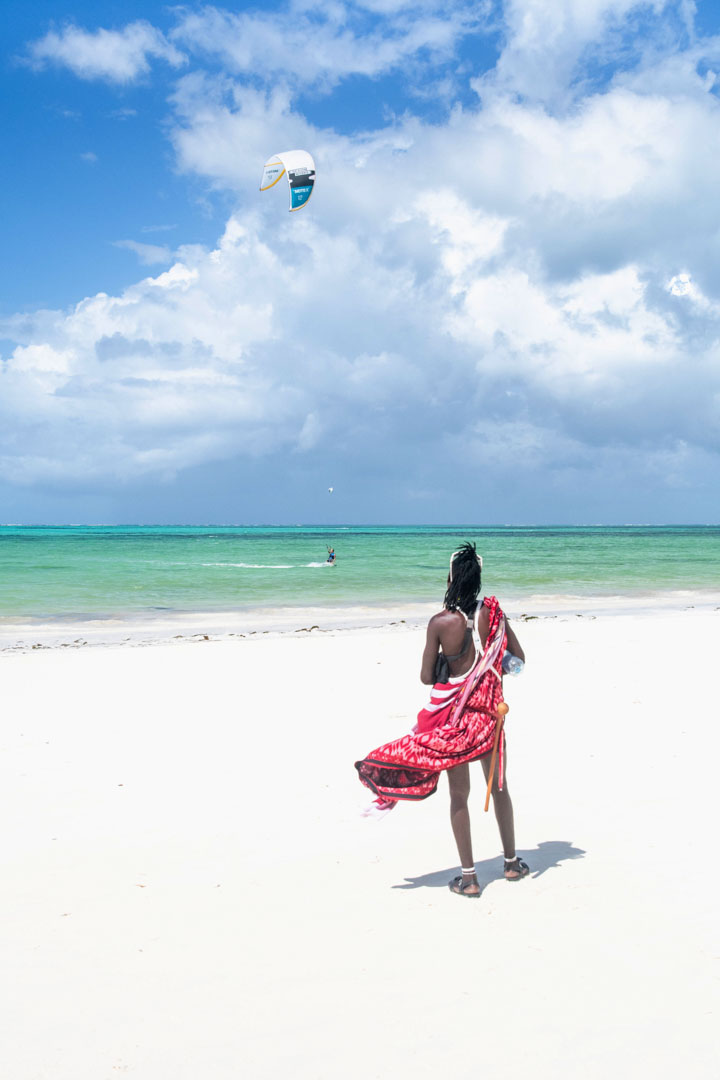Sheboygan, Wisconsin. Not the kind of place one imagines to be known as a surf town, much less dubbed “The Malibu of the Midwest”. It’s even kind of fun to say, Sheboygan. Try it with me… Shah-boy-gan. Sheboygan!
Did you know that Chicken Joe from the animated surf classic, “Surf’s UP!” is actually based on a real life character who lives in Sheboygan? Rumor has it that when “Step Into Liquid” was released and included that clip on Sheboygan’s surf scene, an interview with local surfer Larry Williams caught the attention of the writer for “Surf’s UP!”, who decided to create the personality of Chicken Joe after Williams. So, one might say that Chicken Joe is actually from Sheboygan! Now, that’s a real claim to fame.
But seriously, in Standup Journal’s interviews with the water lovers, business owners and inhabitants of this small Wisconsin town nestled on the edge of Lake Michigan, what strikes us the most is how much the people from Sheboygan love their town. It sounds amazing.
Sheboygan has one of the country’s lowest crime rates, one of the highest educational values (over 90% of high school grads move on to a college level education), and it’s also known as the “bratwurst capital of the world”. Did we mention that people come from all over the world to surf here?
Great Lakes Surf Scene: Center of the Universe
“Some of the longest waves I’ve ever ridden, 200-300 yard long waves, are in Sheboygan.”
Mike Miller, EOS Surf: Sheboygan, Wisconsin
How can a landlocked state like Wisconsin have the longest waves ever ridden by a guy who’s owned a surf shop for 20+ years? Welcome to the world of freshwater surfing, or surfing in the Great Lakes region of the United States.
Did you know that the Great Lakes cover over 11,000 miles of coastline? The lakes themselves cross nine different state lines and include a Canadian province. In the heart of dairyland, the Great Lakes region represents our nation’s greatest coastline. And there’s surfing! Plenty of it if you’re not afraid of a little cold weather.
Sheboygan, Wisconsin sits on the shores of Lake Michigan. This great lake holds 22,440 square miles of water. It is 310 miles long and 10 miles across. On calm days the lake is a great place for beach going, stand up paddling and bonfires along the shoreline. It has something for everyone in every season, and locals will tell you that Lake Michigan offers water enthusiasts kitesurfing, paddleboarding and opportunities to surf especially during the winter months. It is a water lover’s mecca and people travel from all over the midwest and beyond to experience the energy and stoke of the water scene in this “Malibu of the Midwest”. Local surfers call their home break “COTU” for “Center Of The Universe”.
Larry Williams, a.k.a. “Chicken Joe”, says Sheboygan, Wisconsin is the friendliest place on earth to surf. “We work hard to exude the California/Hawaii surf culture and lifestyle in Sheboygan. There is no localism, but an abundance of the aloha spirit. In fact, we believe Sheboygan has the greatest aloha spirit in the world of the Great Lakes,” he says.
“It’s water”, Larry continues. “It runs through your fingers. You can grab up as many armfuls as you want; it will still run through your fingers. It’s water and it’s here for everybody.”
In the surf tribe, Larry and other locals know the best surf happens after Labor Day in Sheboygan. In fact, they consider Labor Day to be the kickoff to the ‘official surf season’ around the Great Lakes, and often have a large party to celebrate it. For them, the true season starts in September and runs all winter long. The conditions that create waves is the friction of wind with the cold air blowing over warmer water. And it gets cold! This is Wisconsin, remember?
Mike Miller, owner of EOS Skate & Surf Shop on Sheboygan’s northern shore, explains that the fetch across the lake - or distance the wind travels across the water - generates waves at the shoreline. The secret to Sheboygan surf is knowing where to look for clean waves along the coast. Up north there is the Elbow, a limestone shelf. Then there is the Jetty, where swells wrap in between two jetties for a rideable wave. There’s also North Point, where the bend of the North Pier offers protection for a south swell wrapping in. In this northern region, the breaks have consistent limestone bottoms that have the potential to create fun surfing waves on a south swell.
Mike is active in building the water culture around Sheboygan. He believes that in order to optimize the lake, which is the backdrop to all of Sheboygan’s activities, a water lover needs to harness the wind as well as the swell. According to Larry Williams, Mike put kiteboarding on the map in the midwest.
Today, kiting is a huge part of the water scene in Sheboygan due to its ‘thermals’ or winds which often come up mid-day around 11AM as the sun heats up the land. The water responds by sending an onshore breeze perfect for kiting and kite surfing. Along the south shore of Sheboygan is Blue Harbor or South Beach, which holds a wide, sandy beach excellent for kiting and “machine like waves” when the thermals blow south. A good day is when you can surf in the morning when the winds are light, and go kiting in the afternoon once the wind comes onshore.
Winter Surfing in Sheboygan: Not for the Faint of Heart
Lake surfers know the best time to surf the lakes is from November through March, when high winds and storms push big, consistent waves topping 20-30 feet with overhead crests, wind whipped barrels, and rides lasting a minute and longer.
While the region’s cold weather waves are some of surfing’s best, the challenging conditions aren’t for everyone. The surf can flow thick and slushy like a Slurpee, or load up with ice the size of soccer balls. Surfers need to be ever vigilant for sheets of ice floating in the surf, as well as changing shore conditions where fast-forming ice shelves blocking the pier can make escape impossible.
Larry Williams has been surfing Sheboygan for over 50 years. He takes his place in the lineup as one of the elders and uses that status to encourage others. He’s surfed the height of winter for a long time in these parts, and knows how to spin a yarn.
“When it’s -24 degrees air temp, which it gets in Wisconsin, remember that doesn’t include the windchill. This is a great lake we’re talking about, so the wind has to be blowing hard in order to generate swell. Let’s say it’s -30 or -40 degrees with the windchill. At those temps, it creates icebergs overnight.”
Larry points out that in order to surf in those temperatures, a surfer must climb up on the pier, which is slick with ice built up against the pilings and must be climbed over to jump in. The question becomes, “How does one get back OUT?” Surfers find breaks or fissures between the blocks of ice and snow forced against the jetties or piers to slide in and out, but often they find that while they are out surfing, the ice sheets shift and now their exit out is blocked. Larry says he was out surfing once when a large chunk of floating ice had closed off his only exit. He had to climb on top of the chunk in order to get out, throwing his board on top of it and then clambering out behind it.
“There are certain conditions you’re not supposed to go out in,” says Larry. “What if you wipe out and do a header into one of these things? There’s times when you can be surfing in high winds and waves in cold temps, and the bays fill up with float ice. When that happens, you can’t surf until the sun melts them.”
When the air temp drops to -20 degrees, the lake develops an ice fog. This happens on certain days when extremely dry, cold air begins evaporating Lake Michigan. It can stick to everything and it freezes immediately. These microscopic droplets of water freeze instantaneously when they hit the air. Larry’s term for the ice fog is ‘poetic’.
So why do people do it?
“Most people can’t handle the freezing cold temps, or care for jumping off those icebergs, but a handful of us have made it through decades together. People may have different views about who we are and how we share about our surfing. But when you’re having fun and you feel it deep in your soul, why wouldn’t you share it?” Larry explains.
The Williams brothers have been sharing their stories of Sheboygan for decades The peculiarity of it brought the producers of ‘Step Into Liquid’ to this midwest town and eventually included it in one of the world’s most iconic surf movies. Larry, and his brother Lee Williams, also collaborated with author William Povletich to write Some Like It Cold, a well-told biographical account of their lifetime growing up and learning to live the surfing life in Sheboygan.
“The thing about surfing is that it’s not like any other sport or lifestyle on earth. It’s how I decorate my house. It’s the vehicle I drive so I can put my longboards on the roof racks. It’s the food we eat. It’s how we raise our children on the beach. It’s how we travel. Surfers even have their own music!. I’ve never heard of golfers who have their own music. We also have our own clothing style,” says Larry.
Both Larry and Mike agree that the great ritual of surfing In Sheboygan includes the after-party in the parking lot or on the beach. No matter how cold it is, surfers gather afterwards to share a few beers and talk about their surfing.
“The best part about ending a surf session is that everybody meets in the parking lot or on the pier to crack a beer, and like fishermen, everybody is lying about the size of the waves that were ridden,” says Williams. “You know you’ve had a good day surfing when you’re laughing beer out of your nose at the end.”
Mike agrees, “The post-session hang out on the beach is the best part. That’s what we come for. That’s where we hang out.”
As a skate and surf shop owner, Mike is also committed to encouraging kids to interact with the lake in Sheboygan which is the backdrop to all they do. He’s introduced a few local women to kiting, and says he tries to get more kids involved in watersports.
“I give them the gear to get them out there. Giving someone access to kiting or surfing is important because it’s not a cheap sport but it's guaranteed to be more fulfilling than soccer or baseball and can become a lifelong commitment. The lake is there. It’s in our backyard. We all need to be out there enjoying it.”
Beyond Surfing: Sheboygan, Wisconsin
Its German-based community has made Sheboygan nationally famous for cheese and bratwurst. A stopover in town includes a mandatory bratwurst sandwich in this “Bratwurst Capital of the World”. The cost of living here is very affordable, with an average house just two blocks from the beach costing in the vicinity of $80,000. In fact, AARP regularly lists Sheboygan, Wisconsin in its “Top 20 Best Places to Live in the United States”.
In addition, Sheboygan is good neighbors with a lot of other attractions, including 3 world-class golf courses within a 12-mile radius, making this area the No.1 golf destination in America. It is situated 17 miles inland from Elkhart Lake’s Road America racetrack, also rated as the No. 1 racetrack in the country, and is located between the cities of Milwaukee (home of Harley Davidson’s headquarters), and Madison, Wisconsin, the state capital and home to five lakes.
To tell the truth, after researching and writing this article, I’m putting Sheboygan high on my places to visit in the near future. The friendliness, affordability and welcoming surf lifestyle are so intriguing that I can’t wait to say to Chicken Joe, “Surf’s UP!”
FUN FACT: Tom Blake, the Father of the Modern Surfboard
Did you know that the No. 1 most influential person in the world of surfing was born and died in Sheboygan? Tom Blake: Surfer, Innovator and Photographer is that man. Blake’s legacy includes redefining surf board shapes with the use of foam and fiberglass to invent the modern surfboard. His board design was the first to receive a patent and, in doing so, he became the first commercial surfboard builder of consequence. His designs are also behind the creation of the first fins used in surfing. Before this invention, surfers used their feet for turning their boards. Blake is also credited with the invention of the surf rescue board, life rings, life vest and the first underwater camera housing.
“Tom’s rescue paddleboard, which lifeguards still use today on a regular basis, continues to be his greatest contribution to humanity, saving tens of thousands of lives on a yearly basis. Furthermore, his unique lifestyle of fusing religion, surfing, swimming, building surfboards, eating and exercising became the model for the burgeoning beach culture. The soul of the stereotypical surfer is rooted in what Tom Blake strove to be in life: at one with the wave.”
- Larry Williams

